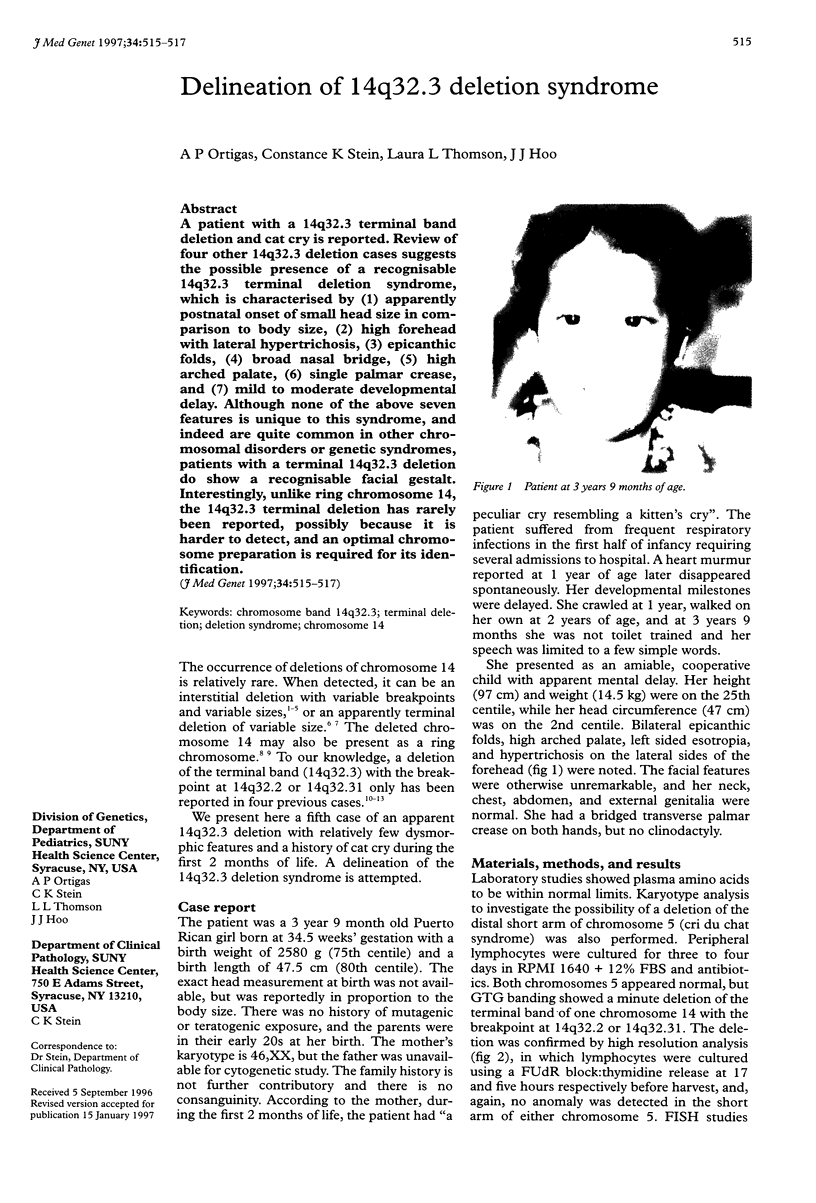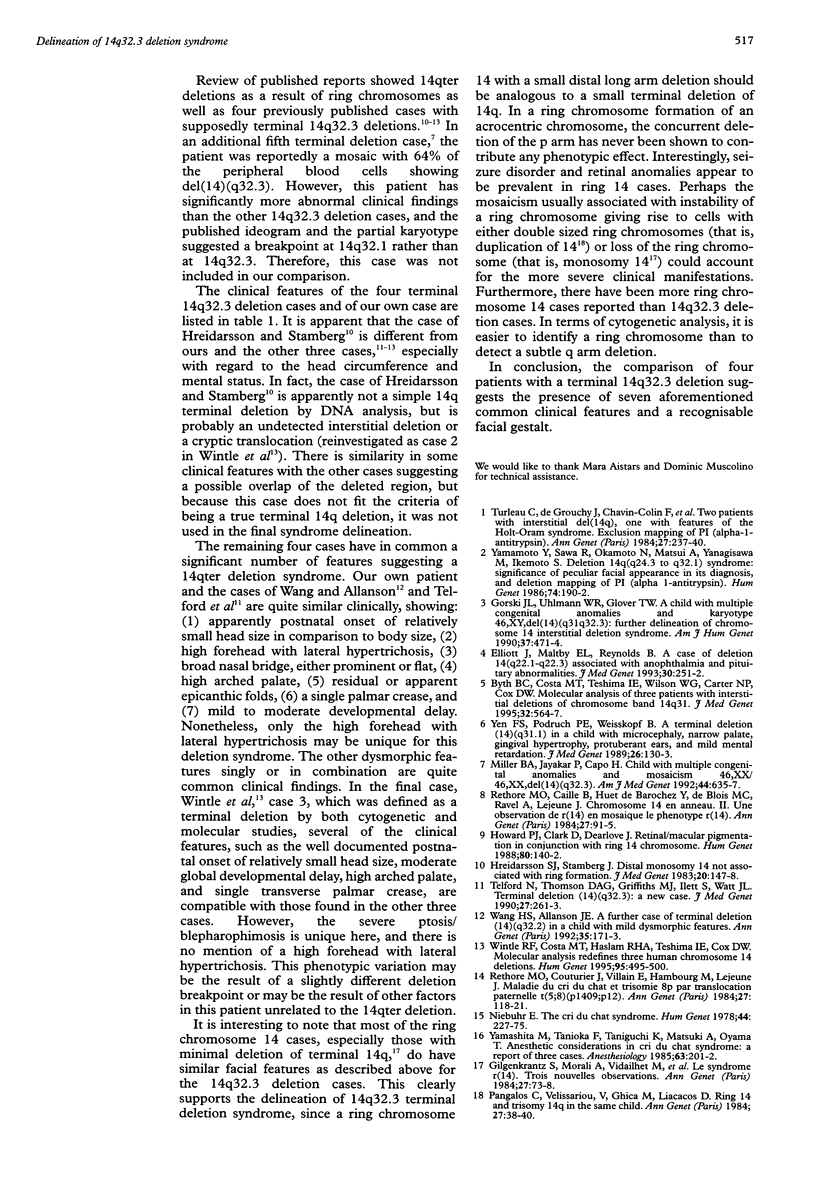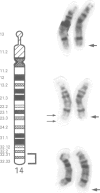Abstract
A patient with a 14q32.3 terminal band deletion and cat cry is reported. Review of four other 14q32.3 deletion cases suggests the possible presence of a recognisable 14q32.3 terminal deletion syndrome, which is characterised by (1) apparently postnatal onset of small head size in comparison to body size, (2) high forehead with lateral hypertrichosis, (3) epicanthic folds, (4) broad nasal bridge, (5) high arched palate, (6) single palmar crease, and (7) mild to moderate developmental delay. Although none of the above seven features in unique to this syndrome, and indeed are quite common in other chromosomal disorders or genetic syndromes, patients with a terminal 14q32.3 deletion do show a recognisable facial gestalt. Interestingly, unlike ring chromosome 14, the 14q32.3 terminal deletion has rarely been reported, possibly because it is harder to detect, and an optimal chromosome preparation is required for its identification.
Full text
PDF


Images in this article
Selected References
These references are in PubMed. This may not be the complete list of references from this article.
- Byth B. C., Costa M. T., Teshima I. E., Wilson W. G., Carter N. P., Cox D. W. Molecular analysis of three patients with interstitial deletions of chromosome band 14q31. J Med Genet. 1995 Jul;32(7):564–567. doi: 10.1136/jmg.32.7.564. [DOI] [PMC free article] [PubMed] [Google Scholar]
- Elliott J., Maltby E. L., Reynolds B. A case of deletion 14(q22.1-->q22.3) associated with anophthalmia and pituitary abnormalities. J Med Genet. 1993 Mar;30(3):251–252. doi: 10.1136/jmg.30.3.251. [DOI] [PMC free article] [PubMed] [Google Scholar]
- Gorski J. L., Uhlmann W. R., Glover T. W. A child with multiple congenital anomalies and karyotype 46,XY,del(14)(q31q32.3): further delineation of chromosome 14 interstitial deletion syndrome. Am J Med Genet. 1990 Dec;37(4):471–474. doi: 10.1002/ajmg.1320370409. [DOI] [PubMed] [Google Scholar]
- Howard P. J., Clark D., Dearlove J. Retinal/macular pigmentation in conjunction with ring 14 chromosome. Hum Genet. 1988 Oct;80(2):140–142. doi: 10.1007/BF00702856. [DOI] [PubMed] [Google Scholar]
- Hreidarsson S. J., Stamberg J. Distal monosomy 14 not associated with ring formation. J Med Genet. 1983 Apr;20(2):147–149. doi: 10.1136/jmg.20.2.147. [DOI] [PMC free article] [PubMed] [Google Scholar]
- Miller B. A., Jayakar P., Capó H. Child with multiple congenital anomalies and mosaicism 46, XX/46,XX, del (14)(q32.3). Am J Med Genet. 1992 Nov 15;44(5):635–637. doi: 10.1002/ajmg.1320440521. [DOI] [PubMed] [Google Scholar]
- Niebuhr E. The Cri du Chat syndrome: epidemiology, cytogenetics, and clinical features. Hum Genet. 1978 Nov 16;44(3):227–275. doi: 10.1007/BF00394291. [DOI] [PubMed] [Google Scholar]
- Pangalos C., Velissariou V., Ghica M., Liacacos D. Ring-14 and trisomy 14q in the same child. Ann Genet. 1984;27(1):38–40. [PubMed] [Google Scholar]
- Rethoré M. O., Caille B., Huet de Barochez Y., de Blois M. C., Ravel A., Lejeune J. Chromosome 14 en anneau. II. Une observation de r(14) en mosaïque. Le phénotype r(14). Ann Genet. 1984;27(2):91–95. [PubMed] [Google Scholar]
- Rethoré M. O., Couturier J., Villain E., Hambourg M., Lejeune J. Maladie du cri du chat et trisomie 8p par translocation paternelle t(5;8)(p1409;p12). Ann Genet. 1984;27(2):118–121. [PubMed] [Google Scholar]
- Telford N., Thomson D. A., Griffiths M. J., Ilett S., Watt J. L. Terminal deletion (14)(q32.3): a new case. J Med Genet. 1990 Apr;27(4):261–263. doi: 10.1136/jmg.27.4.261. [DOI] [PMC free article] [PubMed] [Google Scholar]
- Turleau C., de Grouchy J., Chavin-Colin F., Dore F., Seger J., Dautzenberg M. D., Arthuis M., Jeanson C. Two patients with interstitial del (14q), one with features of Holt-Oram syndrome. Exclusion mapping of PI (alpha-1-antitrypsin). Ann Genet. 1984;27(4):237–240. [PubMed] [Google Scholar]
- Wang H. S., Allanson J. E. A further case of terminal deletion (14)(q32.2) in a child with mild dysmorphic features. Ann Genet. 1992;35(3):171–173. [PubMed] [Google Scholar]
- Wintle R. F., Costa T., Haslam R. H., Teshima I. E., Cox D. W. Molecular analysis redefines three human chromosome 14 deletions. Hum Genet. 1995 May;95(5):495–500. doi: 10.1007/BF00223859. [DOI] [PubMed] [Google Scholar]
- Yamamoto Y., Sawa R., Okamoto N., Matsui A., Yanagisawa M., Ikemoto S. Deletion 14q(q24.3 to q32.1) syndrome: significance of peculiar facial appearance in its diagnosis, and deletion mapping of Pi(alpha 1-antitrypsin). Hum Genet. 1986 Oct;74(2):190–192. doi: 10.1007/BF00282092. [DOI] [PubMed] [Google Scholar]
- Yamashita M., Tanioka F., Taniguchi K., Matsuki A., Oyama T. Anesthetic considerations in cri du chat syndrome: a report of three cases. Anesthesiology. 1985 Aug;63(2):201–202. doi: 10.1097/00000542-198508000-00017. [DOI] [PubMed] [Google Scholar]
- Yen F. S., Podruch P. E., Weisskopf B. A terminal deletion (14)(q31.1) in a child with microcephaly, narrow palate, gingival hypertrophy, protuberant ears, and mild mental retardation. J Med Genet. 1989 Feb;26(2):130–133. doi: 10.1136/jmg.26.2.130. [DOI] [PMC free article] [PubMed] [Google Scholar]




